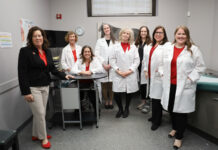The project, a collaboration with scientists and engineers from the University of Kentucky and Western Kentucky University, involves physics experiments on colloids — mixtures of microscopic particles suspended throughout a substance. Examples of colloids include milk, which has microglobules of butterfat suspended in whey, and blood, which contains blood cells suspended in plasma.
UofL mechanical engineering assistant professor Stuart Williams, the project’s principal scientific investigator, said the exact nature of the experiments to be performed still is being determined. Research on the space station is expected to begin June 2015.
Williams said the space station setting provides a “unique research environment” and will help scientists explore how particles interact in zero gravity.The research “will yield insight into the physics of colloidal interactions, which is important for the development of the next generation of sophisticated materials,” he said.
According to researchers, understanding colloidal physics is needed to develop new materials with enhanced energy, thermal, optical, chemical and mechanical properties. Potential applications include more efficient solar energy panels, stronger and lighter aerospace materials and less expensive electronic displays.
Williams said the collaborative nature of the coming project will raise the state’s profile in colloidal research.
The project’s managing principal investigator is Suzanne Smith, UK’s Donald and Gertrude Lester Professor of Mechanical Engineering and director of the NASA Kentucky Space Grant Consortium.
The team also includes Gerold Willing, UofL associate professor of chemical engineering, Hemali Rathnayake, WKU assistant professor of chemistry, Janet Lumpp, UK associate professor of electrical and computer engineering, and NASA partner Ronald Sicker.




























